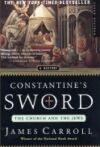 Well, maybe I’m the last person to read it–it’s been on my list for a long time–but I finally finished James Carroll’s Constantine’s Sword: The Church and the Jews. I was expecting perceptive analysis and a comprehensive historical survey of the subject. But what I wasn’t expecting, and was very happy to get, was such a powerful personal narrative. Carroll’s voice and humanity let him tie together the narrative and invest it with a real urgency–a need for change in his own faith and in the world at large.
Well, maybe I’m the last person to read it–it’s been on my list for a long time–but I finally finished James Carroll’s Constantine’s Sword: The Church and the Jews. I was expecting perceptive analysis and a comprehensive historical survey of the subject. But what I wasn’t expecting, and was very happy to get, was such a powerful personal narrative. Carroll’s voice and humanity let him tie together the narrative and invest it with a real urgency–a need for change in his own faith and in the world at large.
His repeated visits to core symbols and motifs (the German town of Trier, the cross at Auschwitz, Marx and Constantine, the seamless robe) get rediscovered with a kind of synchronicity that could have seemed contrived–but which never crosses that line.
I was unfamiliar with a lot of the history, so I learned a lot from that, but what I most enjoyed learning was the connection to the faith and caring of James Carroll.
I would have liked to see more exploration of “the Church and the Jews” in America, rather than exclusively Europe. I think there’s certainly a story to be told there in the later parts of Carroll’s historical analysis, but he kept his focus strictly European. I also felt that, at the end, when he presents his agenda for a Vatican III, the proposals seemed completely unrealistic (although absolutely valuable and required if the kind of transformation he’s proposing is ever going to happen). I just can’t imagine that re-envisioning the New Testament, the structure of power in the Catholic church, and a complete revision of the emphasis on Jesus’ death which has been so central to Christianity is even distantly possible in my lifetime.
Overall, though, I’m thoroughly impressed. I’m glad I finally got a chance to read this–and I know that I’ll be referring to it again.